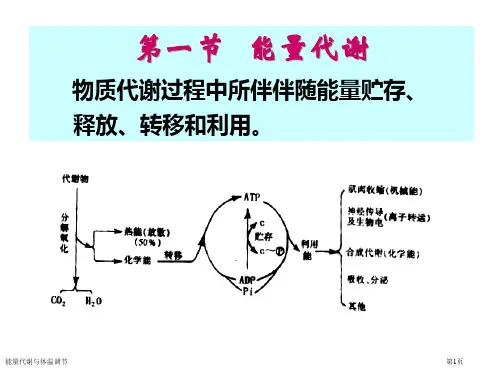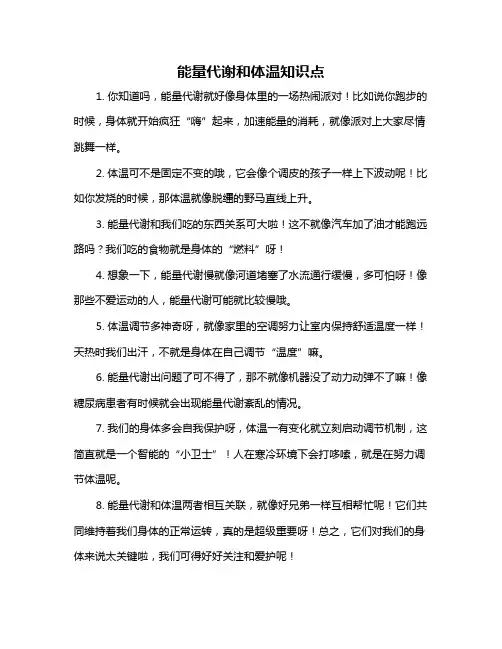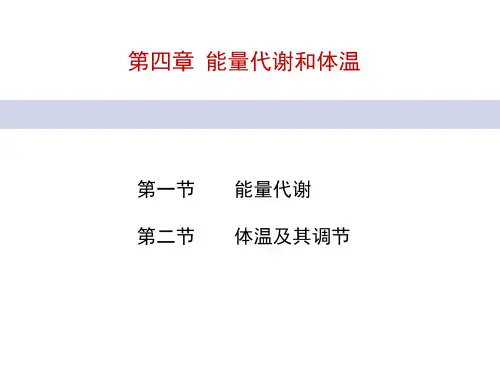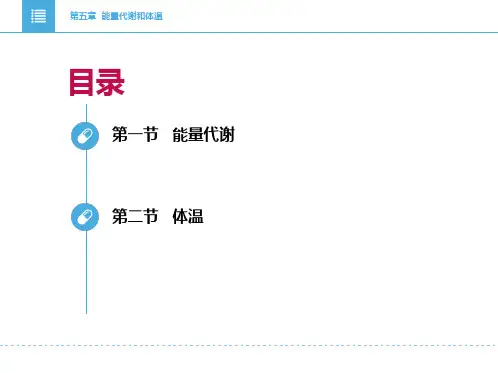能量代谢与体温
- 格式:pdf
- 大小:517.42 KB
- 文档页数:8








能量代谢和体温知识点
1. 你知道吗,能量代谢就好像身体里的一场热闹派对!比如说你跑步的时候,身体就开始疯狂“嗨”起来,加速能量的消耗,就像派对上大家尽情跳舞一样。
2. 体温可不是固定不变的哦,它会像个调皮的孩子一样上下波动呢!比如你发烧的时候,那体温就像脱缰的野马直线上升。
3. 能量代谢和我们吃的东西关系可大啦!这不就像汽车加了油才能跑远路吗?我们吃的食物就是身体的“燃料”呀!
4. 想象一下,能量代谢慢就像河道堵塞了水流通行缓慢,多可怕呀!像那些不爱运动的人,能量代谢可能就比较慢哦。
5. 体温调节多神奇呀,就像家里的空调努力让室内保持舒适温度一样!天热时我们出汗,不就是身体在自己调节“温度”嘛。
6. 能量代谢出问题了可不得了,那不就像机器没了动力动弹不了嘛!像糖尿病患者有时候就会出现能量代谢紊乱的情况。
7. 我们的身体多会自我保护呀,体温一有变化就立刻启动调节机制,这简直就是一个智能的“小卫士”!人在寒冷环境下会打哆嗦,就是在努力调节体温呢。
8. 能量代谢和体温两者相互关联,就像好兄弟一样互相帮忙呢!它们共同维持着我们身体的正常运转,真的是超级重要呀!总之,它们对我们的身体来说太关键啦,我们可得好好关注和爱护呢!。



精品课程生理学教案第七章 能量代谢与体温[目的要求]:1.了解食物的能量指标,能量代谢的测定;2.掌握影响能量代谢的因素,基础代谢率及其测定;3.掌握食物的卡价、氧热价、呼吸商、能量代谢、体温等概念;4.理解影响因素对能量代谢﹑基础代谢﹑体温的作用机制及结果。
[重点]:1.食物的能量指标的几个概念;2.影响能量代谢的因素,基础状态的概念;3.散热的不同方式及体温调节。
[难点]:1.食物的能量指标;2.能量代谢的测定;3.体温调节。
[基本概念]:能量代谢(energy metabolism);合成代谢(anabolism,又称同化作用);分解代谢(catabolism,也称异化作用);动脉血酮体比率(arterial ketone body ratio,AKBR);能量负荷(energy charge,简称能荷);能量代谢率(energy metabolic rate); 热价(thermal equivalent of food);卡价(caloric value);氧热价(thermal equivalent of oxygen);呼吸商(respiratory quotient,RQ);非蛋白呼吸商(non-protein respiratory quotient,NPRQ);食物的特殊动力效应(specific dynamic effect);基础代谢(basal metabolism);基础代谢率(basal metabolism rate,BMR);体温(body temperature);不感蒸发(insensibleperspiration)调定点(set-point); 热敏神经元(warm-sensitive neuron);冷敏神经元(cold-sensitive neuron);温度感受器(thermoreceptors);致热原(pyrogen);体温调节(thermoregulation)[授课学时]:3学时[使用教材]:王庭槐主编. 生理学,第1版,高等教育出版社,2004北京第一节 能量代谢(energy metabolism)定义:机体内伴随物质代谢过程而发生的能量的释放﹑转移﹑贮存和利用的过程。
1.新陈代谢的概念新陈代谢: 维持生命的各种活动过程中化学变化的总称。
新陈代谢包括:物质代谢(同化作用,异化作用);能量代谢(吸热反应,放热反应)图7-1 能量代谢的场所线粒体2.能量贮存形式三大营养物质(糖,脂肪,蛋白质)三羧酸循环 (产生能量的方式)图7 -2 三羧酸循环呼吸链三磷酸腺苷(ATP 能量的贮存形式)图 7–3 ATP生成过程3.食物的能量指标(1)食物热价(thermal equivalent of food):1g某种食物氧化时释放的热量。
(2)食物氧热价(thermal equivalent of oxygen):某种食物氧化时消耗1L氧所产生的热量。
(3)呼吸商(respiratory quotient):各种供能物质氧化时产生的CO2量与O2的消耗量的比值。
(4)非蛋白呼吸商(nonprotein respiratory quotient, NPRQ): 将一定时间内产生的CO2量和消耗O2量减去分解蛋白质产生的CO2量和耗O2量,即为非蛋白质部份(糖和脂肪)氧化产生的CO2量和耗O2量。
一定时间内,氧化糖和脂肪产生的CO2量和耗O2量的比值,称为非蛋白质呼吸商。
4.能量代谢的测定(1)直接测热法(directcalorimetry)特殊的检测环境,测热装置复杂,研究肥胖和内分泌系统障碍。
图7 - 4 直接测热法(2)间接测热法(indirect calorimetry)遵循定比定律,测定CO 2产量 和尿氮排出量,测定耗O 2量,测量装置较简单。
图 7-5 间接测热法 图7 - 6时间耗氧量5. 影响能量代谢强能量代谢越高。
机体任何轻微活动都会提高代谢率,剧烈量现象。
蛋白质作用最强,可“额外”低均可使能量代谢升高。
张度↑ ;, 呼吸﹑循环机能↑(5)其in )等细胞因子卧,未作肌肉活动,前夜睡眠良好,测定时无精神紧张,禁食的因素(1)肌肉活动:肌肉活动越运动时耗O 2量比安静时可增加10~20倍。
(2)精神活动:精神活动越剧能量代谢越高。
(3)食物的特殊动力效应:进食后产生的额外的热增加30%左右,糖、脂肪增加4-6%,混合食物为10%。
它可能是肝脏处理蛋白质分解产物时“额外”消耗的能量。
(4)环境温度:环境温度升高或降20~30℃ 稳定 肌肉松驰;<20℃ 代谢↑ 寒战,肌肉紧<10℃ 代谢↑↑ 寒战,肌肉紧张度↑>30℃ 代谢↑ 体内化学反应速度↑,发汗他因素:年龄、性别、睡眠、激素。
脂肪组织可分泌瘦素(lept 也参与能量代谢的调节。
小分子的脑肠肽Ghrelin 对能量平衡有调节作用。
6. 基础代谢率及其测定基础状态:清晨,清醒,静12小时以上,室温20-25℃。
基础代谢(basal metabolism):基础状态下的代谢状况。
内的能量代谢。
第二节 体温(body temperature)1. 体温的概念ermic animal); 变温动物(poikilothermic animal) 2.产热与散热,骨骼肌。
ng thermogenesis),骨骼肌收缩引起。
散热部位—diation):人体以热射线的形式将体热传给外界。
。
。
基础代谢率(basal metabolism rate):基础状态下单位时间图 7-7 甲状腺疾病患者的基础代谢与正常人基础代谢的比较恒温动物(homeoth 体表温度(shell temperature); 体核温度(core temperature)图 7-8不同环境温度下人体体温分布图产热器官—肝脏产热形式—战栗产热(shiveri 非战栗产热(non-shivering thermogenesis),代谢产热引起皮肤,呼出气,尿,粪。
散热方式:(1)辐射散热(thermal ra (2)传导散热(thermal conduction):机体的热量直接传给同它接触的较冷物体(3)对流散热(thermalconvection):通过同皮肤接触的空气流动将机体热量传给外界(4)蒸发散热(thermal evaporation):通过体表水份的蒸发来散失体热。
可分为:不感蒸发(insensible evaporation),以不显汗的形式蒸发机体水份。
3.体温调(autonomicthermoregulation):增减皮肤血流量,发汗,战栗等生理调节。
外nsitive neuron):当局部组织温度升高时神经冲动的发放频率增加神经元(cold-sensitive neuron):当局部组织温度降低时神经冲动的发放频率增加环境中→冷感受器兴奋→中枢紧张性↑→血管收缩↑→血流量↓→散热↓;另外,→中枢紧张性↓→血管收缩↓→血流量↑→散热↑图 7-9 由下丘脑视前区导出的温度敏感神经元的放电活动体温调定点的体温值,即37℃调定点学说 (set-point theory):调定点按照PO/AH 温度敏感神经元的工作特性来调可感蒸发(sensible evaporation),以汗液蒸发的形式带走热量。
节自主性调节行为性调节(behavioral thermoregulation):增减衣着,开电扇空调等行为。
周和中枢温度感受器:热敏神经元(warm-se 。
冷敏。
(1)在过冷产热↑→维持体温的相对稳定。
(2)在炎热环境中→热感受器兴奋另外,产热↓→维持体温的相对稳定。
(set-point):视前区-下丘脑前部(PO/AH)设定了一个规定。
体温节体温的高低。
图 7-10 体温调节自动控制示意图思考题1. 外呼吸的呼吸商与细胞呼吸的呼吸商有何异同点及联系?2. 能用测定甲状腺激素(T 3,T 4)的水平反映基础代谢率的高低吗?3. 试解释人精神高度紧张时能量代谢和体温的变化过程?4. 急性发热(如疟疾发作)时为何常表现出寒战,高热和大汗退烧的“三步曲”。
5. 试述热环境和冷环境中,体温维持恒定的调节机制。
例:患者蔡某,35岁,工人。
2天前因淋浴受凉后出现体温升高,体温达40.2℃,时有寒,伴有流涕、咳嗽,诊断为普通感冒,经服用阿司匹林后患者大汗淋漓,随后体温下降至.8℃。
题:为什么患者发热时有寒颤现象? 出汗后为什么患者的体温会下降?测部位及其正常值如何?机体温度如何维持? 考文献Hilgemann DW. 1997.Cytoplasmic ATP-dependent regulation of ion transporters and channels: mechanisms Physiol, 59:193=220.Matsuzawa Y. 1997.Pathophysiology and molecular mechanisms of visceral fat ndrome: the Japanese experience(Review). Diabetes Metab Rev, 13(1):3-13C,Walford RL, Harder IT.2000. Energy metabolism after 2 year of energy 2(4):946-953 ew). Physiol Rev, ivity e, 283(5399):212-214 . Ganong WF. 2001.Review of medical physiology.20th ed.人民卫生出版社.271-306 to M,Murakami N,Date Y,et al. 2001.A role for rgrelin in the central ion of feeding. Nature,409(6817):194~198.of Medical Physiology. 10th edition, New York, McGraw-Hill1.Vander A, Sherman J, Luciano D. 2001. Human Physiology. 8th edition, New York, Graw-HillButler J, Lewis R. 1999. Hole's Human anatomy & physiology. 8th edition, y. 案颤37问1、请你解释2、用退热药3、体温的检参1. and messengers(Review). Annu Rev 2.sy 3. Weyer restriction:the biosphere 2 experiment.Am J Clin Nutr,74. Jequier E,Tappy L. 1999.Regulation of body weight in humans(Revi 79(2):451-805. Levine JA, Eberhardt NL, Jensen MD. 1999.Role of nonexercise act therogenesis in resistance to fat gain in humans .Scienc 67. Guyton AC,Hall JE. 2002.Textbook of medical physiology.10th ed.北京医科大学出版社.772-8218. Nakaza regulat 9.Guyton AC, Hall JE. 2000. Textbook Philadelphia: WB saunders Co.10.Lingappa VR, Farey K. 2000. Physiology medicine. 1Mc 12.Shier D,New York, McGraw-Hill13. Andrew Davies, Asa G.H. Blakeley, Cecil Kidd. 2001.Human Physiolog Philadelphia, WB saunders.14. 姚泰:生理学,第5版,人民卫生出版社,2002,ISBN 7-117-03893-4 15. 王庭槐主编. 生理学,第1版,高等教育出版社,2004北京SummaryMetabolism is used to refer to all the chemical and energy transformation occurring in the body, which consists of material metabolism and energy metabolism. Energy metabolism refer ydrates, fats and proteins may become the source of energy of the body. These lly to CO 2, H 2O and the energy ntities of ATP, and that the ATP can in turn be used as an scular ergy phosphate bonds. The ATP and the creatine phosphate contain all high energy n be determined by simply measuring the quantity of heat liberated xertion. The ingested food also increases the metabolic rate . rate usually quantity of protein, the etabolic rate usually increases by about 30%. Another factor that stimulates metabolic rate is the emperature. When the environmental temperature is lower than body temperature , mechanisms such as shivering are activated and the metabolic rate rises. When the te hen a person is at complete rest, considerable energy is required to perform all the chemi nder normal condit to the production, storage, transform, release and utility of energy during the process of material metabolism.The carboh foods can be oxidized in the cell and produced large amounts of energy in this process. The animal organism oxidizes carbohydrates, fats and proteins principa necessary for life processes. It has been pointed out that carbohydrates, fats and proteins can all be used by cells to synthesize large qua energy source for many other cellular functions, including synthesis and growth, mu contraction, glandular secretion, nerve conduction, active absorption, etc. Energy is stored by forming high en phosphate bonds. Creatine phosphate can transfer energy interchangeably with ATP.The metabolic rate ca form the body by direct or indirect methods.The metabolic rate is affected by many factors .The most important one is muscular e After a meal containing a large quantity of carbohydrate or fat, the metabolic increases by only about 4%. However, after a meal containing large m environmental t heat-conserving mperature is high enough to raise the body temperature, there is a general acceleration of metabolic processes. In addition, the metabolic rate is also related to body surface area, age, sex and hormones such as thyroid hormone, epinephrine and norepinephrine, growth hormone etc.Even w cal reactions of the body. This minimum level of energy required to exist is called the basal metabolic rate (BMR). The measurement of the BMR provides a useful means of comparing one person's metabolic rate with that of another under basal conditions.The temperature of human body includes core temperature and the shell temperature. The core temperature is relatively uniform in the core and is regulated within narrow limits by a negative feedback system. The body temperature in physiology means core temperature, i.e., the mean temperature of deep body. In fact, the body temperature is usually indicated by the temperature in the armpit, the mouth (under the tongue) or the rectum. These values normally vary from 36.0℃ to 37.4℃, or 36.4℃ to 37.4℃, or 36.9℃ to 37.9℃ respectively. U ions, the body temperature is easily affected by day and night, sex, age, muscle activity and other factors, but does not normally vary by more than 1℃.Body temperature depends on the production and loss of body heat. The main organs of heat production in human body are the liver, the brain, the heart and the skeletal muscles. The production of heat occurs through basic metabolism and muscle activity and is controlled byneural and humoral factors. The heat is lost largely through the skin. The volume of heat loss from the body depends mainly upon the differences in temperature between the skin and the surroundings. The flow of blood to the vessels in the skin controlled by sympathetic nerves can regulate the skin temperature. Skin loses heat to the external environment by means of four processes :radiation, conduction, convection and evaporation. Sweating is an active secretion of water by sweat gland, which removes heat from the skin as it evaporates. The main sweating contro s center, especially PO/AH in hypot l centre is located in hypothalamus.Thermoregulation includes autonomic thermoregulation and behavioral thermoregulation. Thermoreceptors are divided into peripheral thermoreceptors and central thermoreceptors, which receive cold or hot stimuli. The information converges to the nervou halamus. The efferent impulse results in the production or loss of the heat so as to regulate the body temperature.。